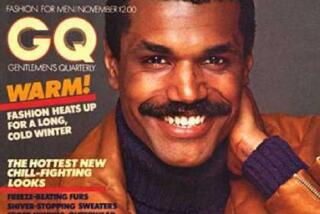Henry Wolf, 80; Art Director Blended Sophisticated Humor, Surrealism
- Share via
Henry Wolf, who as art director for Esquire and later for Harper’s Bazaar helped define sophisticated magazine graphic design starting in the 1950s, has died. He was 80.
Wolf died Feb. 14 at his home in New York City of natural causes, according to his assistant, Caron McCormick.
With a style that blended humor and light-handed surrealism, he made his reputation at the age of 26 as an art director for Esquire. A decade later, he helped create Show, a short-lived arts and entertainment magazine for which he was art director, working for the publication from 1961 until it folded three years later.
Wolf went into advertising, working as an art director at the McCann Erikson agency, whose clients included Buick and Coca-Cola, and later as creative director of Trahey/Wolf, where he helped attract cosmetics industry giants Charles of the Ritz and Elizabeth Arden, among other clients.
He opened his own studio, Henry Wolf Productions, in 1971 and produced catalogs for luxury goods companies, including Saks Fifth Avenue and Van Cleef & Arpels. He also made hundreds of television commercials.
“Henry was a star, and he was very influential for a long time,” graphic designer Milton Glaser said Wednesday. “Henry’s style was superbly clear. There was no complexity or ornamentation. There was clarity, cohesion and restraint.”
Wolf had definite ideas about how to do his job and often voiced them in interviews, in articles for trade publications and in the classroom. Starting in 1954 and throughout his career, he taught at Cooper Union for the Advancement of Science and Art, the School of Visual Arts and Parsons School of Design in New York City.
He believed that graphics should capture a concept rather than repeat a literal point. One of his best-known covers for Esquire illustrated a feature article about American influences on French culture in the 1950s. Wolf’s image showed a packet of “powdered wine” being poured into a glass of water.
He tipped his hat to surrealism with a cover for Harper’s Bazaar in which a fashion model climbs a ladder that is suspended in space. She carries the letter “A” under one arm and is about to place it on a marquee that spells out “Bazaar.”
Wolf credited Alexey Brodovich, the legendary art director for Harper’s Bazaar in the 1940s, as well as surrealist painter Rene Magritte, as his most important teachers. He studied with Brodovich, who pioneered Modernism in graphic art, at the New School for Social Research in the 1940s. He also studied painting with American abstract artist Stuart Davis.
Born in Vienna, Wolf immigrated to the U.S. in 1941 and served in the Army doing intelligence work from 1943 to 1946.
He returned to New York City after his discharge and studied photography, design and painting for several years while he worked in a commercial art studio.
He joined Esquire as a junior staffer in the magazine’s promotions department. Five months later, during a staff shakeup, he was named art director.
Each month at Esquire, Wolf was given at least four open pages to fill with his own inventions. It made him a key influence on the style and substance as well as the look of the magazine.
“I could show Italian labels, French mystery games, magic tricks, whatever,” Wolf said in a 1994 interview with Graphis magazine.
In the same interview, he said the design world had passed him by. Computer graphics turned his hand-drawn and illustrated work into a period piece, he said.
“He hated the direction graphic design was going toward,” Glaser said. “He was bitter, but that was a characteristic of Henry. He was grumpy and generous, thorny and charming. He could be the most charming man in the world.”
Wolf is survived by a sister, Joan Slawson. His two marriages ended in divorce.






